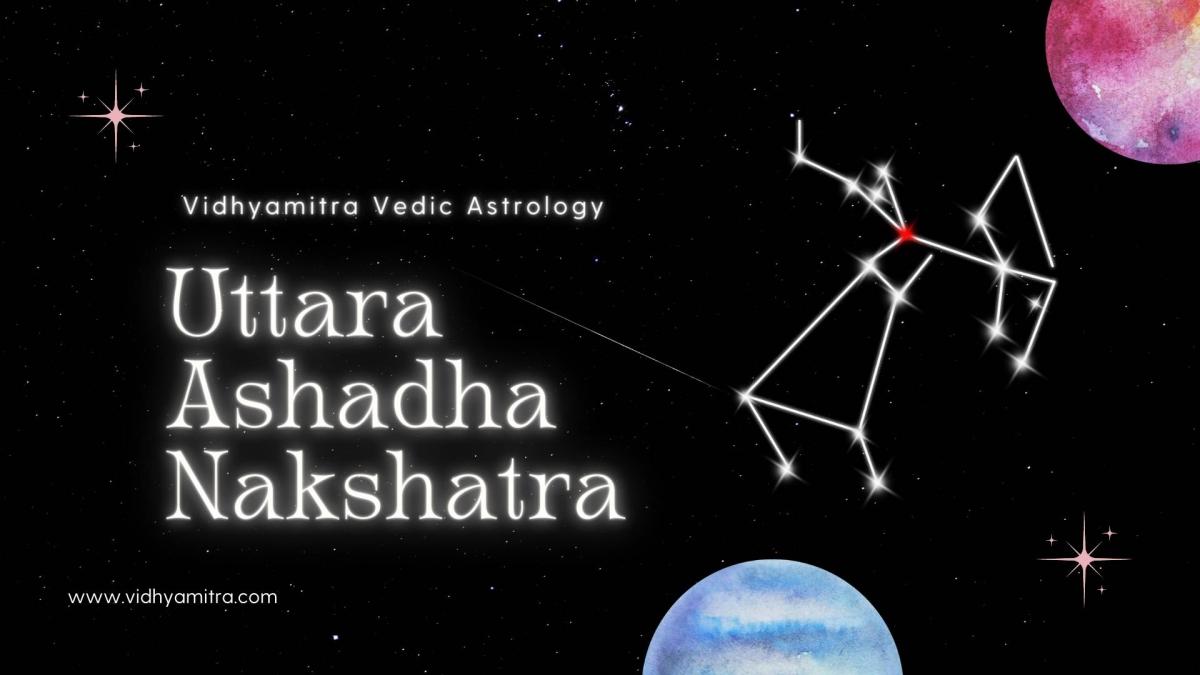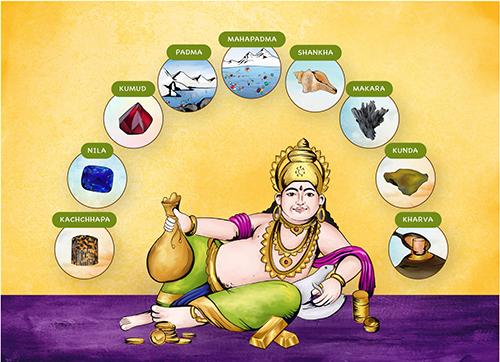
The meaning of the word Ashadha is festival or procession, and Uttara Ashadha means later part of the procession. This means the later part, i.e. the cycle of #birth of a baby, has started.
#UttaraAshadha #Nakshatra in astrology is one of the Urdhvamukhi Nakshatras (or the Nakshatras which have their mouths upwards). In these Nakshatras, things related to palaces, coronations, boundary walls, construction of tall structures can be auspiciously begun and performed.
Symbol: Planks of a Bed
The symbol for Utthara Ashadha is the planks of a bed or a small cot. This is an indication of a baby putting more weight.
Deity: The #Vishwedhevas
The deity of Utthara Ashadha is Vishwedhevas. Vishwedhevas means all Vedic Gods taken together. In Vedas, 33 Gods are identified. These include 8 Vasu, 12 Aadhithya, and 11 Rudhra. Vishwedhevas are the most comprehensive gathering of Gods.
The yoni animal of Uttara Ashadha Nakshatra is the #mongoose.
Mongoose is famously known for one thing, killing the snake and taking its deadly bite.
The mongoose is the one animal that can take on any type of snake species, from cobra, rattlesnake to a black mamba.
The behaviour of the mongoose is that it frustrates, annoys and makes the snake tired and only when the snake is tired does the mongoose attack and kill it with one hit.
Mongooses are also quite fond of Rahu (Pigs), or one of its cousins known as warthogs. They are known to come into the territory of mongooses and have them clean all the lice and ticks off of them.
This not only helps them get cleaned but gives mongoose a nice stuff to snack on.
Mongoose lives in a large group like a colony and is very social.
They are also known to breed between March-May and have a very unpleasant smell.
From the yoni animal, it can be seen that Uttara Ashadha natives will always have snake-like enemies and will flirt with snake-like people.
In a friendship, relationship or with co-workers, Uttara Ashadha natives will crush them or expose them to the world, and they feel undefeated in life.
Just like how mongoose sees the opportunity to kill the snake, Uttara Ashadha folks are extremely opportunistic, and when they see it, they go for it.
They jump into things before anyone else does and are not afraid of the challenge.
The warthogs receiving cleaning from these small relentless creatures show that they are able to help anyone in any type of condition.
They do not see species, colour, creed or caste.
Since pigs are connected with Varaha avatar, representing Rahu, and Rahu represents Muslims, Uttara Asahadha will always make a Muslim friend or have a Muslim lover in their life. It will be of a great benefit because, like the mongoose gets to feed on the ticks and lice of the wild pig, the Uttara Ashadha native will also be able to get many things to feed on through such people easily.
Due to the colonization nature of mongooses, they are very social.
They always want to take over things and set up their own eutopia wherever they go.
The symbol of this Nakshatra is the elephant’s tusk, which again shows that these natives are prolific writers.
They can write a trilogy and something as epic as Mahabharata written by the great Hindu God Ganesha.
The elephant’s tusk is pretty much a tooth, which Ganesha broke off and turned into an ink pen.
There are rumours that the originally written book by Ganesha is locked in the Padmanabhaswamy temple of Lord Vishnu.
The broken tooth shows dental issues that Uttara Ashadha natives need to deal with if this Nakshatra is influenced by malefics and posited in the 6th, 8th or 12th house.
Vishwadevas or the Universal Gods are the deities of Uttara Ashadha Nakshatra.
The universal Gods or the Vishwadevas have the power to grant #invincible #victory.
Viswadevas deals with universal moral principles.
The qualities governed by them are goodness, truth, willpower, time, desire, skillfulness, forbearance, ancestors, abundance and summit/peak.
Lord #Ganesha, the elephant-headed God, is also connected with this asterism for being the one in charge of karma.
Lord #Krishna is supposed to have displayed his true form, or the Vishwaroopa, to Arjuna in Mahabharata’s Kurukshetra, where he had the entire Universe, the Gods ruling the Universe as being one- Lord Krishna.
The animal connected with this Nakshatra is the mongoose, which could also be connected with Lord #Kubera, who carries a mongoose skin purse, and rules the North direction connected with Mercury.
Abhimanyu, son of Arjuna, may also be connected with the last pada of this Nakshatra, as he was the one who broke through the Chakravyuha formation in the Mahabharata but ended up dying.
Parikshit, the son of Abhimanyu, was the only one who survived the Pandava clan even after getting impacted by Brahmastra from Ashwatthama.
The mythology clearly shows that Uttara Ashadha natives are undefeated in most of their undertakings.
They take the right and proper actions to make sure the victory is on their side.
Like Purva Ashadha Nakshatra natives, they are strategic about what type of war they are entering into and how they will conquer their mission.
Vishwa Devas are about morals and principles, and it translates into these natives as the anchor of their lifeboat.
Even the mob boss or a hard-minded criminal will have a set of principles that they will build their foundation on, like never killing children, women, or someone without a cause.
If you pay attention to the mythology, you will understand the word “Universal God”, meaning Uttara Ashadha natives do not have a single-minded approach to a single religion.
They believe in one universal God, one defining omnipresence.
They are always interested in anthropology, history and colonization of different religious beliefs in different regions of the world.
Krishna, who revealed his true self to Arjuna in the middle of the battlefield, becomes a key figure in this Nakshatra.
Krishna was known to be very apt, and he cheated many times in the Mahabharata to give Pandavas the advantage against their cousins.
The cheating was fair, as rules of the battle were not followed initially by Kauravas.
Uttara Ashadha natives are not afraid of cheating when they realize their enemy is serving them the same dish.
These natives are always in search of the answer of the true universe origins and who created this entire existence due to Krishna showing his Vishwaroopa (universal God form) to Arjuna.
Krishna also died with an arrow hit on the left foot by Jara, and so these natives always have sprained ankles and injury to their knee or leg, especially Saturn being the ruler of the Capricorn side.
Uttara Ashadha natives are the most powerful individuals within themselves.
One of the key features of someone who is in the power/position is their way of conducting themselves.
For example, a powerful banker, mob boss or CEO have a habit of always wearing the best things and smoking cigars.
Cigars have been the key symbol of such people to show their power in the world.
This Nakshatra deals with time, and they love to wear the best wristwatches so that they can keep track of time.
Saturn, the ruler of the Capricorn sign, is also the karaka of time.
Uttara Ashadha natives come to change things, and they make a big impact on society.
They feel it is their duty to give light to society at any cost, even if it means sacrificing their comfort and life. Uttara Ashadha stands for later victory.
When a person has this Nakshatra dominating in their chart, they will lose many battles in the early life but later become invincible and undefeated.
Attributes of Uttara Ashadha Nakshatra in Astrology
Spread from 26’40” Sagittarius (Dhanu) to 10’00” of Capricorn (Makara).
Lord is Jupiter (Guru) and Saturn (Shani). The derivatives from Uttara Ashadha are closely allied to those of Purva Ashadha.
The points of difference are that Poorva Ashadha spreads out, and it is concerned with extensiveness.
On the other hand, Uttara Ashadha is introspective and penetrative and is concerned with intensiveness, the results of the latter being more permanent than the former (Poorvashadha).
The deity who preserves this world and makes for its welfare is called ‘ganadevata’or Vishwadevatas.
There are ten ganadevatas Basu, Satya, Kratu, Daksha, Kala, Kama, Dhriti, Kuru, Pururaba, Madraba.
All their attributes are in this star. The warrior, the wrestler, the painter, the artist, the magician, the well-dressed man, the happy and successful men are influenced by this star.
A special characteristic of it is that it causes the native to be admired and socially applauded.
Another characteristic of it is that under the influence of this star, the native falls in love with an unmarried girl.
Bhishma of the Mahabharata was one of the 8 Basus, so under this star, one possesses self-control, restraint, endurance and firm character. There are special rituals for the worship of ganadevatas, which are more or less of specialised nature.
Description of Uttara Ashadha Nakshatra in Vedic Astrology Treatise
According to Hora Sara: The native born in Uttara Ashadha Nakshatra will like fun, be modest, have many enemies, be distressed, distinguished knowledge, will wander, have many wives, and be kind.
According to Jataka Parijata: If a native is born in the star Uttara Ashadha, he will be honourable, of tranquil nature, happy, possess wealth and learned.
According to Sage Narada: The native born in Uttara Ashadha will be grateful, righteous, heroic, will beget many sons, be modest, will have an excellent spouse and be charming.
According to Brihat Samhita: The star Uttara Ashadha will make one modest, virtuous, have many friends, grateful and attractive.
https://vidhyamitra.com/uttara-ashadha-nakshatra-in-astrology-characteristics-padas-remedies/

